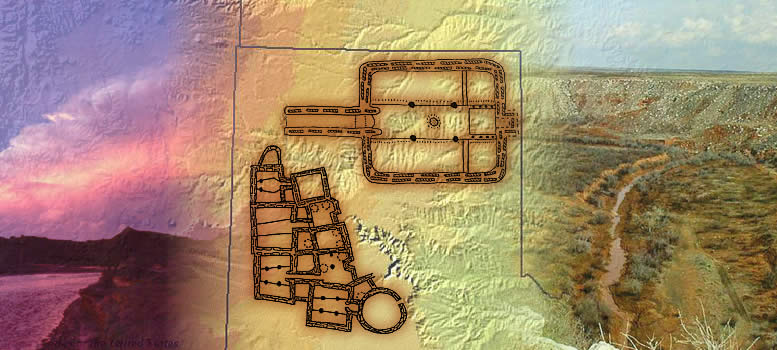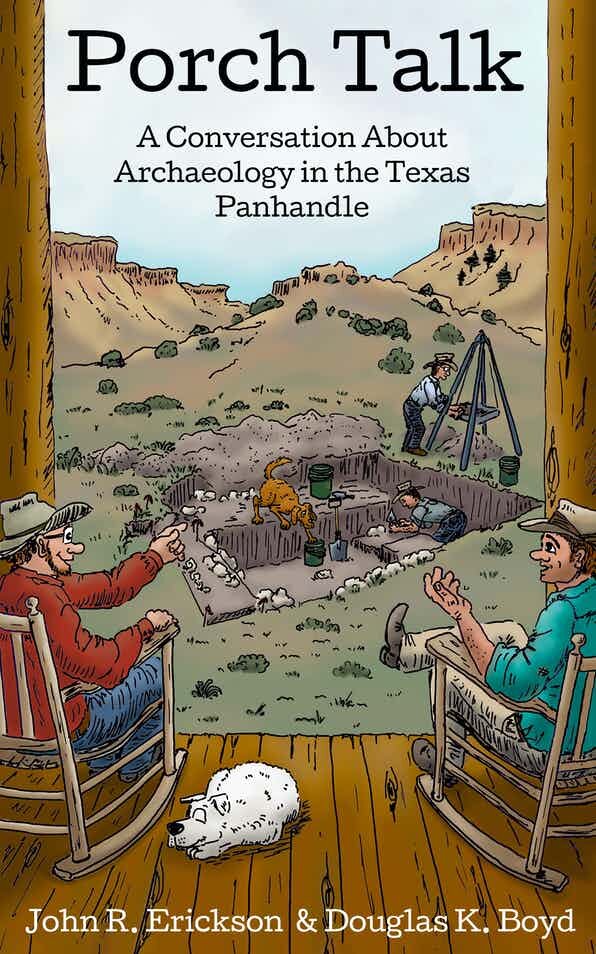
- History of Plains Villager Research in the Texas Panhandle
- Buried City: Plains Villager Life along Wolf Creek:
- Hank's House 1: Anatomy of a Burned Pithouse
- Hank's House 2: A Puzzle Wrapped in a Mystery
- Making Cordmarked Pottery
Contrary to conventional wisdom and traditional histories, the Texas Panhandle was not "settled" first in the late 1800s; it was, in fact, settled first some 800-900 years ago by prehistoric Plains villagers who left behind abundant and unmistakable evidence of their sustained presence. The stone ruins of many once-thriving Indian villages and hamlets can still be found today in the valleys and broken terrain along the Canadian River and various other upper stretches of tributaries of the Arkansas and Red rivers. Who were these people? How did they live? Why did they leave? Where did they go? How do we know?
The villagers who lived in the Texas Panhandle were part of a much larger pattern of semi-settled life in the Great Plains known as the Plains Village tradition. Between roughly A.D. 1100 and 1500, these now-ruined settlements were home to Indian peoples who depended in part on a combination of bison hunting and horticulture (gardening) and staked out their home territories in what is today the Texas Panhandle. Locally, the best-known Plains Village tradition is the Antelope Creek culture centered in the Canadian River Valley not far north and northeast of Amarillo, Texas. Antelope Creek villagers lived in substantial houses sometimes arranged in blocks of rooms somewhat similar to small Southwestern pueblos. They hunted buffalo and other game, collected many kinds of wild plants, grew corn and other crops with simple farming techniques, quarried local materials such as Alibates flint, and otherwise settled the land and made it their home for centuries.
The story of this remarkable culture has never been fully told, however, and much of what has been presented previously to the public is an outdated and false caricature. Once dubbed the Texas Panhandle Pueblo culture, the villagers were portrayed as peaceful corn farmers and buffalo hunters sharing much in common with the Pueblo Indians of the American Southwest. In contrast, the view today of the Antelope Creek and related Plains villagers who lived in the Texas Panhandle and adjacent areas of the Southern Plains is one of small-scale societies competing with one another, sometimes violently, and living a precarious existence in a land often inhospitable. Climatic and ecological data suggest that prehistoric corn farming in much of the region was, at best, a risky endeavor—hunting and gathering may have provided the bulk of the diet. Repeated droughts and the arrival of Apache groups from the northwest are thought to have ended the first era of settled life in the Texas Panhandle less than a century before the Coronado expedition entered the region in 1541.
The historical relationships between the prehistoric villagers of the Southern Plains (including those in the Texas Panhandle) and specific historic and modern Indian groups are poorly understood. Plains villagers had abandoned much of western and southwestern parts of the Southern Plains by A.D. 1500. Most archeologists and historians who have studied the problem believe that the ancient villagers were ancestral speakers of one or several of the Northern Caddoan languages: Wichita, Pawnee, Arikira, and Kitsai. That said, attempts to link specific archeological cultures with specific historically known groups have been tentative and speculative at best. All of the Northern Caddoan groups migrated over hundreds of miles during their known histories, a pattern that had its roots thousands of years earlier. (See Caddoan Languages and Peoples to learn more.)
The Plains Villagers of the Texas Panhandle exhibits are aimed at bringing the results of almost 100 years of research to the public. The villagers who lived in the Texas Panhandle for over three centuries represent a little-known part of the cultural heritage of Texas. While their lives might seem completely different from ours today, they lived in the same environment and faced many of the same challenges that Panhandle residents today face. One word sums up a big problem then and now. Water. Not enough of it, not enough of it when and where it's needed, and not enough of it to sustain the agricultural practices that people then and now would have preferred to follow.
Five exhibits focus on the theme "Plains Villagers of the Texas Panhandle." In the future we hope to add additional exhibits that will help flesh out the remarkable stories of a long-gone and all-but-forgotten people, the first settlers of the Southern Plains.
- History of Plains Villager Research in the Texas Panhandle Special exhibit reviewing the history of archeological research on the Plains Village sites of the Texas Panhandle and of changing ideas about the Antelope Creek culture.
- Buried City: Plains Villager Life along Wolf Creek Site exhibit on the Buried City complex along Wolf Creek in Ochiltree County, Texas, summarizing the history of investigations and the results of almost 20 years of research led by Dr. David Hughes, author of the exhibit.
- Hank's House 1: Anatomy of a Burned Pithouse Site exhibit on a recently excavated Plains Village house in Roberts County. In 2000, rancher and author John Erickson discovered what proved to be a Plains Village pithouse that mysteriously burned in the early 1300s. Archeologist Doug Boyd tells the story of Hank's house, named for Erickson's fictional character, Hank the Cowdog. Check out the related Kids' Activities, new in 2022.
- Hank's House 2: A Puzzle Wrapped in a Mystery Special exhibit by John Erickson in the form of a wide-ranging essay reviewing archeological thinking about the Plains villagers of the Texas Panhandle and offering fresh insight as seen from the West Pasture of the M-Cross Ranch.
- Making Cordmarked Pottery Special exhibit that explains how to make the distinctive cordmarked pottery favored by Antelope Creek villagers in the Texas Panhandle. Panhandle native and retired teacher Alvin Lynn shares what he has learned through many years of trial and error.
Exhibit Support
The development of the "Plains Villagers of the Texas Panhandle" exhibits was supported by funding from the Texas Preservation Trust Fund of the Texas Historical Commission, the Texas Archeological Research Laboratory, the Harold Courson family, the Texas Archeological Society, and the Council of Texas Archeologists. The staff of the Panhandle-Plains Historical Museum provided invaluable access to the museum's collections and archives. Archeologists Scott D. Brosowske and Pat Mercado-Allinger served as outside (peer) reviewers for all of the exhibits.
NEW 2022 Porch Talk: A Conversation About Archaeology in the Texas Panhandle
This book aimed at school children and students of archeology was written by TBH Plains Village exhibit contributers John Erickson (author of the Hank the Cowdog book series) and archeologist Doug Boyd. When John Erickson saved up and purchased a tract of Panhandle property near Perryton, it set off a chain of discovery. Who lived in Texas over a thousand years ago? In Porch Talk, John Erickson and his archeologist friend Doug Boyd investigate this question while explaining the art and science of archeology for middle school readers. The book also features some other real life Texas archeologists. Teachers will be interested in an associated Educator's Guide that has eight social studies lesson plans available! Find the book and free Educator's Guide at Texas Tech University Press and the guide plus accompanying instructional videos through Plains Archeological Research.
